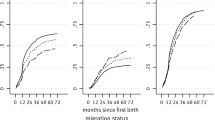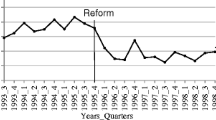Abstract
Sweden is a welfare state with a family policy that strongly emphasizes equality without distinction by place of birth or gender. In this study, we investigate the differences in uptake of parental leave between native and immigrant mothers, and the connection to labour-market attachment. Sweden represents a unique case study, not only because of the strong effort to combine work and family for all women and men, the high level of fertility and the large presence of immigrants in the country; it also enables a detailed and sophisticated analysis based on the high-quality data derived from its population registers. We find that immigrant mothers use more parental leave benefit the first year after their child’s birth, but then fewer in the second year compared with native mothers. The differences diminish when labour-market activity is controlled for. Additionally, after a time in Sweden, immigrant mothers use leave more similarly to how native mothers do.


Similar content being viewed by others
Notes
There is no difference between December children and all children regarding the mother’s age, but for children with a native mother there is a difference regarding educational level. Native mothers with children born in December have a significantly lower than average educational level. For immigrant mothers, we find no differences between those having children in December and during the rest of the year. As immigrant mothers tend to have lower education, they are more similar to native mothers of December children than to other native mothers. As our aim is to test the difference between these groups, we believe that, if anything, our results would be even stronger if we could use children born during the whole year.
Only 0.54 % of natives ever emigrated during the observation period.
Results not shown; please contact the authors for details.
References
Albrecht, J. W., Edin, P.-A., Sundström, M., & Vroman, S. B. (1999). Career interruptions and subsequent earnings: A reexamination using Swedish data. Journal of Human Resources, 43, 294–311.
Andersson, G. (2000). The impact of labor-force participation on childbearing behaviour: Pro-cyclical fertility in Sweden during the 1980s and the 1990s. European Journal of Population, 16(4), 293–333. doi:10.1023/A:1006454909642.
Andersson, G. (2004). Childbearing after migration: Fertility patterns of foreign-born women in Sweden. International Migration Review, 38, 747–774.
Andersson, G., Hoem, J., & Duvander, A. (2006). Social differentials in speed-premium effects in childbearing in Sweden. Demographic Research, 14, 51–70.
Andersson, G., & Scott, K. (2005). Labour-market status and first-time parenthood: The experience of immigrant women in Sweden, 1981–1997. Population Studies, 59, 21–38.
Andersson, G., & Scott, K. (2007). Childbearing dynamics of couples in a universalistic welfare state: The role of labor-market status, country of origin, and gender. Demographic Research, 17, 897–938.
Behtoui, A., & Neergaard, A. (2010). Social capital and wage disadvantages among immigrant workers. Work Employment Society, 24, 761–779. doi:10.1177/0950017010380640.
Bevelander, P. (2000). Immigrant employment integration and structural change in Sweden, 1970–1995. Södertälje: Almqvist and Wiksell International.
Bevelander, P., & Groeneveld, S. (2010). How many hours do you have to work to be integrated? Full-time and part-time employment of the native and ethnic minority women in the Netherlands. International Migration, 50, 117–131.
Bevelander, P., & Skyt Nielsen, H. (2001). Declining employment success of immigrant males in Sweden: Observed or unobserved characteristics? Journal of Population Economics, 14(3), 455–471. doi:10.1007/s001480000036.
Blossfeld, H.-P., Klijzing, E., Mills, M., & Kurz, K. (Eds.). (2005). Globalization, uncertainty and youth in society. London: Routledge.
Borjas, G. J. (1992). Ethnic capital and intergenerational mobility. Quarterly Journal of Economics, 107, 123–150.
Boyd, M. (1984). At a disadvantage: The occupational attainment of foreign-born women in Canada. International Migration Review, 18, 109–120.
Brandén, M. (2014). Gender migration patterns within a sex segregated labor market. Stockholm: Stockholm University Demography Unit—Dissertation Series 10
Bygren, M., & Duvander, A. (2006). Parents’ workplace situation and fathers’ parental-leave use. Journal of Marriage and the Family, 68, 363–372.
Clark, K., & Drinkwater, S. (2002). Enclaves, neighbourhood effects and employment outcomes: Ethnic minorities in England and Wales. Journal of Population Economics, 13, 5–30.
Corijn, M., & Klijzing, E. (Eds.). (2001). Transitions to adulthood in Europe. Dordrecht: Kluwer Academic Publishers.
Dribe, M., & Lundh, C. (2011). Cultural dissimilarity and intermarriage. A longitudinal study of immigrants in Sweden 1990-2005. International Migration Review, 45(2), 297–324.
Duvander, A. (2010). Immigrants’ use of parental leave in Sweden. In L. B. Knudsen & A. Linhardt-Olsen (Eds.), Our demographic future—a challenge. On the need for demographic analyses (pp. 203–224). Aalborg: Scandinavian Population Studies.
Duvander, A., & Eklund, S. (2006). Utrikesfödda och svenskfödda föräldrars föräldrapenninganvändande. In P. de los Reyes (Ed.), Om välfärdens gränser och det villkorade medborgarskapet. SOU 2006:37 (pp. 33–68). Stockholm: Fritzes.
Duvander, A., & Johansson, M. (2012). What are the effects of reforms promoting fathers’ parental-leave use? Journal of European Social Policy, 22(3), 319–330.
Duvander, A., & Olsson, S. (2001). När har vi råd att skaffa barn? RFV Analyserar 2001:8. Stockholm: National Social Insurance Board.
Edin, P. A., LaLonde, R. J., & Åslund, O. (2000). Emigration of immigrants and measures of immigrant assimilation: Evidence from Sweden. Swedish Economic Policy Review, 7, 163–204.
Ellingsaeter, L. (2009). Leave policy in the Nordic welfare states: A ‘recipe’ for high employment/high fertility? Community, Work & Family, 12(1), 1–19.
Evertsson, M., & Duvander, A. (2010). Parental leave - possibility or trap? Does family leave length effect Swedish women’s labour market opportunities? European Sociological Review, 27(4), 435–450.
Ferrarini, T., & Duvander, A. (2010). Earner-carer model at the cross-roads: Reforms and outcomes of Sweden’s family policy in comparative perspective. International Journal of Health Services, 40(3), 373–398.
Government. (2014). Budgetproposition 2014, prop 2013/14:1. See http://www.regeringen.se/content/1/c6/22/37/09/57378fb7.pdf.
Government Commission. (2012). Benefit and trap. Parental benefit claims by recently arrived immigrants. Government commission [SOU] 2012:9. Stockholm: Fritzes.
Hagström, M. (2009). Country Report Sweden, PROMINSTAT. Malmö: Malmö University.
Helgertz, J. (2010). Thou shalt not pass? Examining the existence of an immigrant glass ceiling in Sweden, 1970-1990. Demographic Research, 24, 1–44.
Hosmer, D. W., & Lemeshow, S. (2000). Applied logistic regression. New York: Wiley-Interscience.
Klein, J. P., & Moeschberger, M. L. (2003). Survival analysis: Techniques for censored and truncated data (2nd ed.). New York: Springer.
Le Grand, C., & Szulkin, R. (2002). Permanent disadvantage or gradual integration: Explaining the immigrant-native earnings gap in Sweden. Labour, 16, 37–64. doi:10.1111/1467-9914.00186.
Le, A. T., & Miller, P. W. (2010). Glass ceiling and double disadvantage effects: Women in the US labour market. Applied Economics, 42, 603–613.
Lundström, K. E., & Andersson, G. (2012). Labor market status, migrant status, and first childbearing in Sweden. Demographic Research, 27(25), 719–742.
Magnusson, C. (2010). Mind the gap. Essays on explanations of gender wage inequality. Swedish Institute for Social Research Dissertation Series 78. Stockholm: Swedish Institute for Social Research.
Milewski, N. (2007). First child of immigrant workers and their descendants in West Germany: Interrelations of events, disruption, or adaptation? Demographic Research, 17(29), 859–896.
Mussino, E., & Strozza, S. (2012). The fertility of foreign immigrants after their arrival: The Italian case. Demographic Research, 26(4), 99–130.
National Social Insurance Board. (2003a). Mamma vet bäst. En kunskapsmätning om föräldrapenning och föräldraledighet. RFV Analyserar 2003:19, Stockholm: National Social Insurance Board.
National Social Insurance Board. (2003b). Gravida kvinnors situation. RFV Analyserar 2003:7. Stockholm: National Social Insurance Board.
Ohlsson-Wijk, S. (2011). Sweden’s marriage revival: An analysis of the new-millennium switch from long-term decline to increasing popularity. Population Studies, 65(2), 183–200.
Oláh, L. S., & Bernhardt, E. (2008). Sweden: Combining childbearing and gender equality. Demographic Research, 19, 1105–1144.
Parrado, E. (2011). How high is Hispanic/Mexican fertility in the United States? Immigration and tempo considerations. Demography, 48(3), 1059–1080.
Pedraza, S. (1991). Women and migration: The social consequences of gender. Annual Review of Sociology, 17, 303–325.
Persson, L. (2001). Arbetsmarknadsstatus och fruktsamhet. Påverkar anknytningen till arbetsmarknaden kvinnors och mäns barnafödande? Demografiska rapporter 2001: 2. Stockholm: Statistics Sweden.
Persson, L., & Hoem, J. M. (2014). Immigrant fertility in Sweden, 2000-2011: A descriptive note. Demographic Research, 30, 887–897.
Rajiman, R., & Semyonov, M. (1997). Gender, ethnicity, and immigration. Double disadvantage and triple disadvantage among recent immigrant women in the Israeli labor market. Gender & Society, 11(1), 108–125.
Rebhun, U. (2008). A double disadvantage? Immigration, gender, and employment status in Israel. European Journal of Population, 24, 87–113.
Rønsen, M., & Sundström, M. (2002). Family policy and after-birth employment among new mothers—A comparison of Finland, Norway and Sweden. European Journal of Population, 18, 121–152.
Rosholm, M., Roed, M., & Schøne, P. (2006). Are new work practices and new technologies biased against immigrant workers?. No: IZA Discussion Papers. 2135.
Scott, K. (1999). The immigrant experience: Changing employment and income patterns in Sweden 1970-1993. Lund: Lund University Press.
Statistics Sweden. (2008). Integration. A description of today’s Sweden. Integration Rapport 1. Stockholm: Statistics Sweden.
Statistics Sweden. (2009). Integration—utrikes födda på arbetsmarknaden. Integration: Rapport 2. Stockholm: Statistics Sweden.
Statistics Sweden. (2010a). Integration—en beskrivning av läget i Sverige. Integration: Rapport 6. Stockholm: Statistics Sweden.
Statistics Sweden. (2010b). Betydelsen av tid i Sverige för fruktsamheten. Bakgrundsmaterial för Demografi, Barn och Familj 2012:1. Stockholm: Statistics Sweden.
Statistics Sweden. (2013). Statistisk årsbok. Stockholm: Statistics Sweden.
Sundström, M., & Duvander, A. (2002). Gender division of child care and the sharing of parental leave among new parents in Sweden. European Sociological Review, 18(4), 433–447.
Swedish Social Insurance Agency. (2005). Social insurance in Sweden 2005. Stockholm: Swedish Social Insurance Agency.
Swedish Social Insurance Agency. (2014). Social insurance in figures 2014. Stockholm: Swedish Social Insurance Agency.
Tang, J. (1997). The career attainment of Caucasian and Asian engineers. The Sociological Quarterly, 34(3), 467–496. doi:10.1111/j.1533-8525.1993.tb00122.x.
Vikman, U. (2013). Paid parental leave to immigrants: An obstacle to labor market entrance? Working paper 2013:4, Uppsala: Institute for evaluation of labour market and education policy.
Acknowledgments
This study was partly funded by the Swedish Research Council through the Swedish Initiative for Research on Microdata in the Social and Medical Sciences (SIMSAM) and partly by the Family Dynamics in Europe (SPaDE), Grant Registration Number 349-2007-8701. We are very grateful to the anonymous referees and Helga De Valk who through their valuable suggestions have enabled us to greatly improve the article.
Author information
Authors and Affiliations
Corresponding author
Appendix
Appendix
See Table 4.
Rights and permissions
About this article
Cite this article
Mussino, E., Duvander, AZ. Use It or Save It? Migration Background and Parental Leave Uptake in Sweden. Eur J Population 32, 189–210 (2016). https://doi.org/10.1007/s10680-015-9365-x
Received:
Accepted:
Published:
Issue Date:
DOI: https://doi.org/10.1007/s10680-015-9365-x




